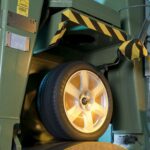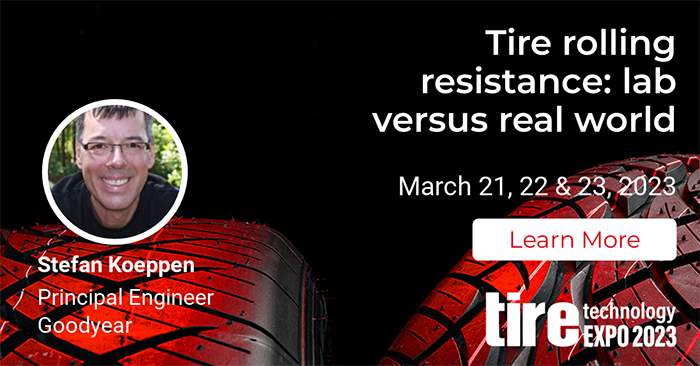 Taking place in Hannover next month (March 21-23, 2023), this year’s Tire Technology Expo Conference will gather more than 130 speakers across three days, including Stefan Koeppen, principal engineer at Goodyear. With considerable industry interest in improving testing and simulation, Tire Technology International recently caught up with Stefan to find out more about his presentation, ‘Tire rolling resistance – lab versus real world‘.
Taking place in Hannover next month (March 21-23, 2023), this year’s Tire Technology Expo Conference will gather more than 130 speakers across three days, including Stefan Koeppen, principal engineer at Goodyear. With considerable industry interest in improving testing and simulation, Tire Technology International recently caught up with Stefan to find out more about his presentation, ‘Tire rolling resistance – lab versus real world‘.
What is your presentation about?
SK: Challenging energy-efficiency requirements, the need to reduce emissions and the transition to EVs all increase the relevance of tires in the vehicle energy economy. The amount of energy dissipated by tires in real-world applications depends on the operating conditions and vehicle and mission profile. Laboratory rolling resistance (RR) tests according to ISO or SAE procedures do not consider several of these factors. My presentation will cover the effects of ambient temperature on tire RR, a comparison of lab and on-road RR measurements, examples of RR in transient operating conditions and how intelligent tires can support analysis of these parameters.
What are the effects of ambient temperature on tire RR?
SK: Rolling resistance is generated by cyclic deformations of a tire passing through its footprint and the related hysteretic effects due to viscoelastic material properties. These properties are temperature dependent and that is why RR is affected by ambient temperature. This is true for both consumer and commercial tires, as I will show in my presentation.
The loss modulus tan d increases with decreasing temperature, leading to an increased level of rolling resistance at low ambient temperature. With the transition to EVs, the effect of ambient temperature on tire RR receives greater attention as it is directly linked to range and efficiency. At Goodyear, we investigate these effects together with our OEM partners in a proactive and innovative manner.
How do laboratory rolling resistance tests compare with real-world tests?
SK: The huge advantage of laboratory tests is that one can control test conditions and always keep them at the defined level. That is different from outdoor road testing, where you must accept current ambient conditions or travel to remote locations.
Laboratory tests according to SAE or ISO standards are developed to measure tire RR in a very accurate and repeatable way. The current ISO 28580 standard evolved from previous test procedures and was improved in several areas, for example by defining tighter test conditions for less variation. It also includes a section on laboratory alignment that was added in the context of tire labeling.
We know that real-world vehicle and tire operating conditions cover a huge range and can vary significantly; think about changes in ambient conditions at different times of the year or in different regions. The type of driving pattern or mission profile adds variability – just consider a truck in long-haul or municipal application.
To summarize, laboratory RR tests are very well suited to compare, rank and label tires and we must further investigate their role in predicting vehicle energy economy.
What examples will you give of RR in transient operating conditions?
SK: In this context, transient operating conditions mean changes in tire RR due to variations in speed and/or temperature.
Referring to laboratory tests, they include a tire warm-up phase to reach thermal equilibrium prior to the RR measurement. That fact is already an indication that tire RR is not a constant value but depends on the tire operating conditions. There is literature available that describes transient effects on tire rolling resistance. In my presentation I will show examples that we measured, and discuss the order of magnitude of transient tire operating effects.
How can intelligent tires support analysis of these parameters?
SK: At Goodyear we develop intelligent tires to monitor tire temperature, inflation pressure and, in advanced developments, also parameters such as tire load, treadwear status or other items that are beneficial for the customer.
Using intelligent tires, we collect relevant information related to the tire status and operating conditions. We can use that information directly during vehicle operation and additionally in our processes to develop tires that deliver good RR performance in the laboratory as well as favorable energy economy on the road.
 How is Goodyear improving tire testing and simulation?
How is Goodyear improving tire testing and simulation?
SK: We operate advanced RR test equipment. As an example, two of our test machines located at the Goodyear Innovation Center Luxemburg are part of the EC network of reference laboratories for tire labeling. I was a member of the Expert Group on Laboratory Alignment (EGLA), which developed the concept of reference labs now included in Regulation (EU) 2020/740. In conclusion, I think it is fair to say that we are well positioned in terms of testing.
In addition, we not only comply with the requirements of regulations and tire testing standards but also exceed them and analyze a larger range of operating conditions both in testing and in simulation. We continuously develop our testing capabilities, and I will talk about that in my presentation as well.
Simulation offers great opportunities to investigate a large variety of operating conditions, material properties and tire designs. This is especially true in connection with virtual tire development.
What is the key message you want to share with the audience at Tire Technology Expo?
SK: I want to share the message that tire rolling resistance is not one single number but is affected by a significant number of variables. We investigate these effects in our global Goodyear Innovation Centers and combine existing and new capabilities to further improve the energy economy of our product portfolio.
Stefan will be speaking on Day 2 of the conference (March 22), during the ‘Improvements in tire testing and simulation’ session. Book your conference pass here.




